Recognizing and identifying people: A neuropsychological review
- PMID: 26773237
- PMCID: PMC4754142
- DOI: 10.1016/j.cortex.2015.11.023
Recognizing and identifying people: A neuropsychological review
Abstract
Recognizing people is a classic example of a cognitive function that involves multiple processing stages and parallel routes of information. Neuropsychological data have provided important evidence for models of this process, particularly from case reports; however, the quality and extent of the data varies widely between studies. In this review we first discuss the requirements and logical basis of the types of neuropsychological evidence to support conclusions about the modules in this process. We then survey the adequacy of the current body of reports to address two key issues. First is the question of which cognitive operation generates a sense of familiarity: the current debate revolves around whether familiarity arises in modality-specific recognition units or later amodal processes. Key evidence on this point comes from the search for dissociations between familiarity for faces, voices and names. The second question is whether lesions can differentially affect the abilities to link diverse sources of person information (e.g., face, voice, name, biographic data). Dissociations of these linkages may favor a 'distributed-only' model of the organization of semantic knowledge, whereas a 'person-hub' model would predict uniform impairments of all linkages. While we conclude that there is reasonable evidence for dissociations in name, voice and face familiarity in regards to the first question, the evidence for or against dissociated linkages between information stores in regards to the second question is tenuous at best. We identify deficiencies in the current literature that should motivate and inform the design of future studies.
Keywords: Face; Familiarity; Hub; Name; Semantic; Voice.
Copyright © 2015 Elsevier Ltd. All rights reserved.
Figures
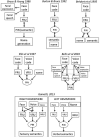


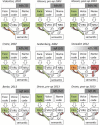
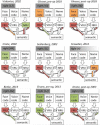
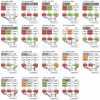
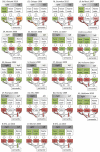

Similar articles
-
The relation between person identity nodes, familiarity judgment and biographical information. Evidence from two patients with right and left anterior temporal atrophy.Brain Res. 2010 Jan 11;1307:103-14. doi: 10.1016/j.brainres.2009.10.009. Epub 2009 Oct 22. Brain Res. 2010. PMID: 19836361
-
Integration of faces and voices, but not faces and names, in person recognition.Br J Psychol. 2012 Feb;103(1):73-82. doi: 10.1111/j.2044-8295.2011.02044.x. Epub 2011 May 17. Br J Psychol. 2012. PMID: 22229775
-
What the study of voice recognition in normal subjects and brain-damaged patients tells us about models of familiar people recognition.Neuropsychologia. 2011 Jul;49(9):2273-82. doi: 10.1016/j.neuropsychologia.2011.04.027. Epub 2011 May 4. Neuropsychologia. 2011. PMID: 21569784 Review.
-
Famous people recognition through personal name: a normative study.Neurol Sci. 2018 Apr;39(4):663-669. doi: 10.1007/s10072-018-3251-3. Epub 2018 Jan 30. Neurol Sci. 2018. PMID: 29383617
-
Implications of recent findings for current cognitive models of familiar people recognition.Neuropsychologia. 2015 Oct;77:279-87. doi: 10.1016/j.neuropsychologia.2015.09.002. Epub 2015 Sep 7. Neuropsychologia. 2015. PMID: 26359717 Review.
Cited by
-
Effects of Faces and Voices on the Encoding of Biographic Information.Brain Sci. 2022 Dec 15;12(12):1716. doi: 10.3390/brainsci12121716. Brain Sci. 2022. PMID: 36552175 Free PMC article.
-
The Twenty Item Prosopagnosia Index (PI20) provides meaningful evidence of face recognition impairment.R Soc Open Sci. 2021 Nov 3;8(11):202062. doi: 10.1098/rsos.202062. eCollection 2021 Nov. R Soc Open Sci. 2021. PMID: 34737872 Free PMC article.
-
The processing of intimately familiar and unfamiliar voices: Specific neural responses of speaker recognition and identification.PLoS One. 2021 Apr 16;16(4):e0250214. doi: 10.1371/journal.pone.0250214. eCollection 2021. PLoS One. 2021. PMID: 33861789 Free PMC article.
-
Prosopagnosia: current perspectives.Eye Brain. 2016 Sep 26;8:165-175. doi: 10.2147/EB.S92838. eCollection 2016. Eye Brain. 2016. PMID: 28539812 Free PMC article. Review.
-
Dynamic neural architecture for social knowledge retrieval.Proc Natl Acad Sci U S A. 2017 Apr 18;114(16):E3305-E3314. doi: 10.1073/pnas.1621234114. Epub 2017 Mar 13. Proc Natl Acad Sci U S A. 2017. PMID: 28289200 Free PMC article.
References
-
- Anaki D, Kaufman Y, Freedman M, Moscovitch M. Associative (prosop)agnosia without (apparent) perceptual deficits: a case-study. Neuropsychologia. 2007;45(8):1658–1671. doi: S0028-3932(07)00026-7 [pii] 10.1016/j.neuropsychologia.2007.01.003. - PubMed
-
- Ardila A. People recognition: a historical/anthropological perspective. Behav Neurol. 1993;6(2):99–105. doi: 10.3233/BEN-1993-6205 N897100562310854 [pii] - PubMed
-
- Barton J, Cherkasova M. Face imagery and its relation to perception and covert recognition in prosopagnosia. Neurology. 2003;61:220–225. - PubMed
-
- Barton J, Press D, Keenan J, O'Connor M. Lesions of the fusiform face area impair perception of facial configuration in prosopagnosia. Neurology. 2002;58:71–78. - PubMed
-
- Barton J, Zhao J, Keenan J. Perception of global facial geometry in the inversion effect and prosopagnosia. Neuropsychologia. 2003;41:1703–1711. - PubMed
Publication types
MeSH terms
Grants and funding
LinkOut - more resources
Full Text Sources
Other Literature Sources

